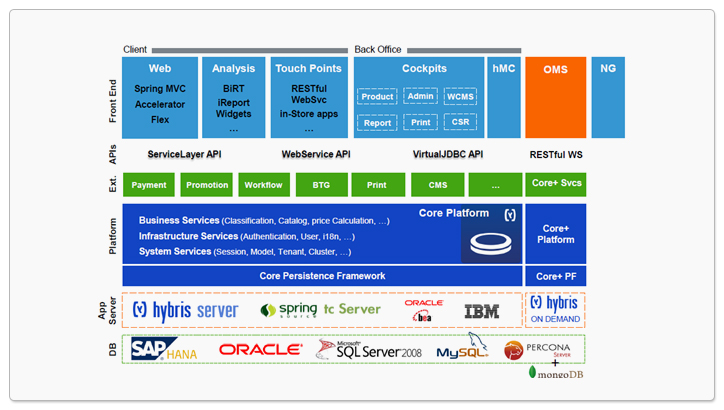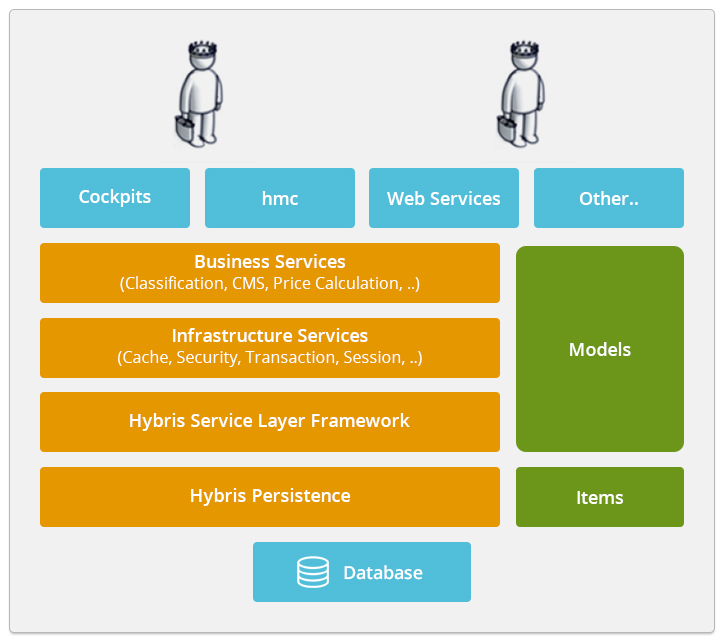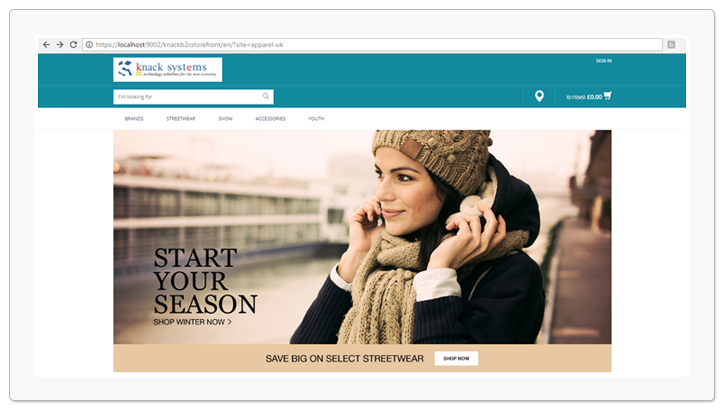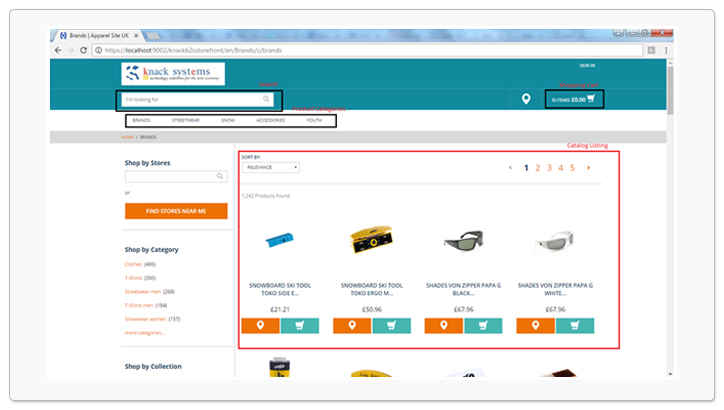We live in an age where everyone is well-accustomed to purchasing goods online – better known as B2C these days. And success levels in B2C increase with the ability to maintain online stores. Maintaining stores becomes trickier when you have multiple stores to manage. What do you do to ensure flawless management in such a scenario?
How do firms that value speed-of-service play the eCommerce game?
To accelerate the time required for the go-to-market in the B2C process, the SAP eCommerce platform offers a solution known as the Commerce Accelerator. This solution suits organizations that prioritize speed and fits their needs perfectly.
Here is the high level architecture of the SAP Commerce Suite: This should give us a brief idea on the architecture of SAP Commerce.
And now, let me get you better-acquainted with the SAP Commerce suite.
Layered Architecture:
| Layer Name | Description |
|
Cockpits, hmc, WebServices |
This is where objects are represented in a way that an end-user can interact with them: such as add products to a cart, edit a product description, or set a password for a user account. In this layer, it is possible to let a user perform an action Involving an object in the SAP Platform via a graphical user interface. |
|
Service Layer Framework |
Implements the Java Application Programmer'sInterface (API) for objects in the SAP Commerce Suite, the SAP API. |
|
Type Layer |
Describes business object models. It is on this layer that definitions of business objects (types) and their fields (attributes) are made via the items.xml items.xml file. Models are generated based on types. |
|
Persistence Layer |
Deals with abstraction from the database,caching, and clustering. You are not probable to achieve association with the Persistence Layer at all as it is entirely clear and does not need any specific communication from your end |
|
Database |
Albeit not a layer of the SAP Commerce Suite, the database too is a valuable constituent in this overview: the database renders the data contained in the SAP Commerce Suite constant. |
Why SAP Commerce (B2C Accelerator)?
The SAP B2C Commerce application is a particularly integral, omni-channel commerce offering that accredits you to convey an extraordinary customer experience along both digital and physical touchpoints.
For those companies whose needs are not unique and who need to get started quickly, the SAP Commerce Accelerator is a perfect ready-to-use solution. It is an omni-commerce tool that is absolutely customizable, allowing support for call-center, mobile, and order management. Simply re-brand one of the store front templates and use the SAP software to integrate with your order fulfillment system and payment service provider.
Key points:
- Web pages can be managed via WCMS, and this can be handled by business users.
- With SAP Commerce Accelerator in place, you do not have to create brand new web stores, which would take ages to deliver with endless deadlines. In fact, there is a complete set of samples provided to users with the SAP Commerce suite.
- The SAP B2C Commerce Accelerator comes with the best internationalization capacity granting you the power to be omnipresent with a multi-site, multi-language, multi-currency experience.
- As of SAP Commerce 5.7, you can now have both B2B and B2C stores running in the same instance.
- Interact with clients contextually and regularly across each touchpoint via the omni-channel solution.
SAP B2C Commerce Accelerator Explained
As an SAP and Web Channel Consultant for a trusted firm, I’ve noticed that the ready-to-use web framework of the SAP Commerce Accelerator has - without fail - empowered our customers to kick-start their implementations and readily frame and sustain the commerce solution.
SAP Commerce provides two out-of-the-box sample stores along with other standard features: the Apparel storefront and the Electronics storefront.
B2C Electricals Storefront
The B2C Electricals storefront demonstrates support for:
- Single shared multi-language/multi-currency storefront for the US and Japan territories
- Product dataset: Electricals (classification product data)
- Languages EN, DE, JP
- Currencies: USD, JPY
- Product catalogs: One shared, multi-currency/multi-language product catalog demonstrating Electrical (classification) product data. EN & DE translations supplied.
- Content catalogs: one shared, multi-language content catalog
B2C Apparel Storefront
The B2C Apparel storefront demonstrates support for:
- Separate single-language/single-currency storefronts for the UK and Germany territories
- Languages EN, DE
- Currencies: GBP, EUR
- Product catalogs: one shared multi-currency/multi-language product catalog demonstrating Apparel (variant) product data. EN & DE translations supplied.
- Content catalogs: Two separate language-specific content catalogs
Cockpits:
Another interesting module in SAP Commerce is cockpits. You can maintain products in the product cockpit so that even if there is a need to modify the product description, you can accomplish it by virtue of the product cockpit without making a change to the code. Similarly, the solution has a CMS cockpit that allows marketing content to be updated without any dependence on the IT team.
HMC or BackOffice:
HMC or Backoffice is the single user interface where you can access stores, sites, products, users, companies, and catalogs. In short, it allows you to manage any kind of data from the same interface.
Features of B2C Accelerator:
- Standard eCommerce content pages with WCMS integration for desktop and mobile with device detection
- Full text search capability and integration with Apache Solr
- Product details with stock availability indicators
- Store locator with Google Maps integration
- Customer reviews and Social Network integration
- Persistent shopping cart with multiple checkout strategies
- Guest and Express Checkout
- Address Verification and Localized Addresses
- Standard fulfillment or Buy Online Pickup In Store (BOPIS)
- Customer account management and order history
- Integration with payment service providers with Hosted Order Page (HOP) or Silent Order Post (SOP)
- Integration with Customer Service and In Store channels
- Reporting and analytics integration
- Integration with SAP Commerce OMS and CIS
- Latest Versions of SAP Commerce Accelerator include a responsive UI
A look at B2C Storefront:
Here are the homepage and catalog listing pages for the custom B2C application, which is running on the SAP 6.0 Commerce suite.
The content from the homepage is derived from the CMS cockpit. You can change or personalize the look and feel right from the cockpit.
Product Listing Page
Once the sample store (like the one in shown in the screenshot) is configured, you can browse through or search for products and place orders. In order to go the full mile with SAP eCommerce, you need to have a complete understanding on the SAP Commerce Suite.
Want to get constant value from Knack Systems on the SAP Commerce suite? Subscribe to our free updates with insights, tips, and trends to help make your work easier and more successful.








